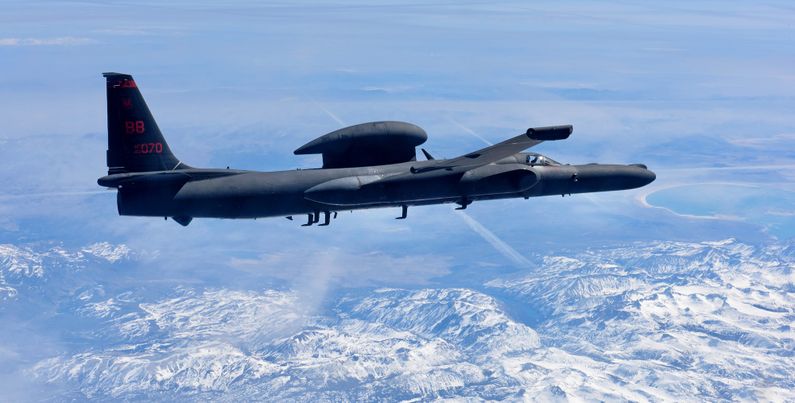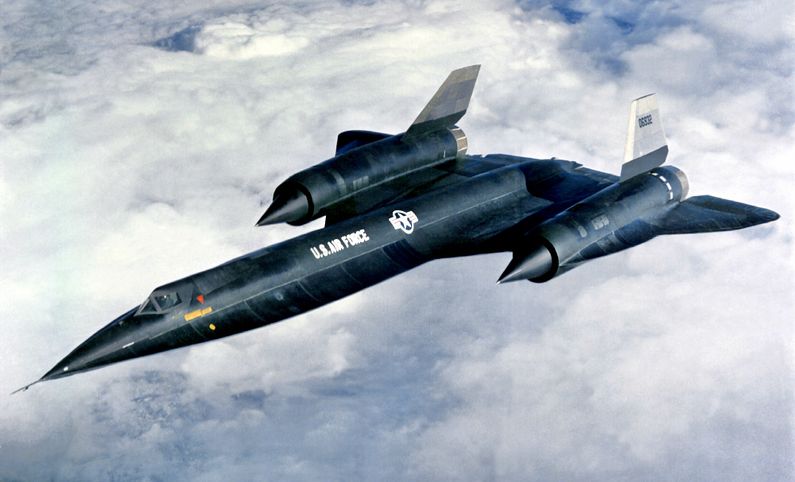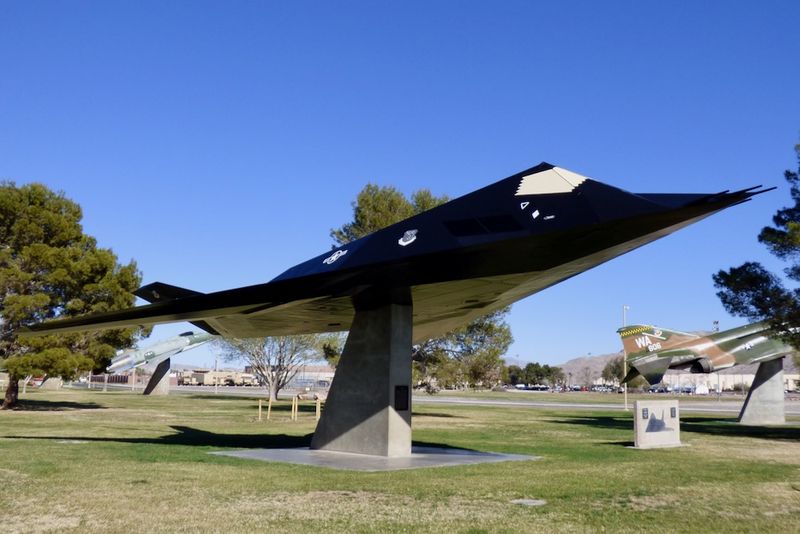Groom Lake Airfield
|
U-2 Project Dragon Lady The Central Intelligence Agency (CIA) established the Groom Lake test facility in April 1955 to develop the Lockheed U-2 strategic reconnaissance aircraft. Project director Richard M. Bissell Jr.conducted a search for a suitable testing site for the U-2 aircraft and sent an inspection team out to Groom Lake, Nevada. The dry lake bed made an ideal strip for testing aircraft, and the Emigrant Valley's mountain ranges and the Nevada Test Site (NTS) perimeter protected the site from visitors; it was about 100 mi north of Las Vegas. The CIA asked the AEC to acquire the land, designated "Area 51" on the map, and to add it to the Nevada Test Site. On 4 May 1955, a survey team arrived at Groom Lake, laid out a 5,000-foot north-south runway on the southwest corner of the lakebed, and designated a base support facility site. The site initially consisted of little more than a few shelters, workshops, and trailer homes in which to house its small team. A little over three months later, the base consisted of a single paved runway, three hangars, a control tower, and rudimentary accommodations for test personnel. The base's few amenities included a movie theater and volleyball court. There was also a mess hall, several wells, and fuel storage tanks. CIA, Air Force, and Lockheed personnel began arriving by July 1955. The first U-2 was delivered on 24 Jul 1955 from Burbank on a C-124 Globemaster II cargo plane. According to Lockheed Martin, the U-2S/ER-2 remains today as the highest-flying, single-engine airplane in service today with 31 aircraft in inventory (27 one-seat and 4 two-seat trainers). A 2015 USAF Fact Sheet states that the U-2s were home based at the 9th Reconnaissance Wing, Beale Air Force Base, California, but are rotated to operational detachments worldwide. U-2 pilots are trained at Beale using five two-seat aircraft designated as TU-2S before deploying for operational missions. A-12 Project OXCART The Lockheed A-12 was a high-altitude, Mach 3+ reconnaissance aircraft built for the United States Central Intelligence Agency (CIA) by Lockheed's Skunk Works. The A-12 was produced from 1962 to 1964 and flew from 1963 to 1968. It was the precursor to the twin-seat U.S. Air Force SR-71 Blackbird, a slightly longer variant able to carry a heavier fuel and camera load. By August 1961, construction of the essential facilities was complete; three surplus Navy hangars were erected on the base's north side while hangar 7 was new construction. The original U-2 hangars were converted into maintenance and machine shops. Facilities in the main cantonment area included workshops and buildings for storage and administration, a commissary, a control tower, a fire station, and housing. The Navy also contributed more than 130 surplus Babbitt duplex housing units for long-term occupancy facilities. Older buildings were repaired, and additional facilities were constructed as necessary. A reservoir pond surrounded by trees served as a recreational area one mile north of the base. Other recreational facilities included a gymnasium, a movie theater, and a baseball diamond. A permanent aircraft fuel tank farm was constructed by early 1962 for the special JP-7 fuel required by the A-12. Seven tanks were constructed, with a total capacity of 1,320,000 gallons. Security was enhanced for the arrival of the A-12 and the small mine was closed in the Groom basin. In January 1962, the Federal Aviation Administration (FAA) expanded the restricted airspace in the Groom Lake area, and the lakebed became the center of a 600-square mile addition to the restricted area R-4808N. The CIA facility received eight USAF F-101 Voodoos for training, two T-33 Shooting Star trainers for proficiency flying, a C-130 Hercules for cargo transport, a U-3A for administrative purposes, a helicopter for search and rescue, and a Cessna 180 for liaison use, and Lockheed provided an F-104 Starfighter for use as a chase plane. The first A-12 test aircraft was covertly trucked from Burbank on 26 Feb 1962 and arrived at Groom Lake on 28 Feb 1962. It made its first flight on 26 Apr 1962 when the base had over 1,000 personnel. The closed airspace above Groom Lake was within the Nellis Air Force Base Range airspace, and pilots saw the A-12 20 to 30 times. Groom was also the site of the first Lockheed D-21 drone test flight on 22 Dec 1964. By the end of 1963, nine A-12s were at Area 51, assigned to the CIA-operated "1129th Special Activities Squadron". The Air Force began funding improvements to Area 51 in 1977. In 1979, the CIA transferred jurisdiction of the Area 51 site to the Air Force Flight Test Center at Edwards Air Force Base, California. Sam Mitchell, the last CIA commander of Area 51, relinquished command to USAF Lt. Col. Larry D. McClain. F-117 Nighthawk Project Have Blue The Lockheed Have Blue prototype stealth fighter was a smaller proof-of-concept model of what became the Air Force F-117 Nighthawk, it first flew at Groom Lake Airfield in December 1977. In 1978, the Air Force awarded Lockheed Corporation a full-scale development contract for the F-117. On 17 Jan 1981, the Lockheed test team at Groom Lake accepted delivery of the first full-scale development prototype, designated YF-117A. On 18 Jun 1981, Lockheed test pilot Hal Farley first flew the YF-117A from the Groom Lake Airfield. Tactical Air Command (TAC) set up the 4450th Tactical Group on 15 Oct 1979 at Nellis AFB, Nevada to guide the F-117A to an initial operating capability. The group was physically located at Groom Lake Airfield. That Group also operated the A-7D Corsair II as a trainer for the F-117A. These operations continued until 15 Oct 1982 under the guise of an avionics test mission. Two Flying squadrons were organized under the 4450th TG, the 4450th Tactical Squadron activated on 11 Jun 1981, and the 4451st Tactical Squadron on 15 Jan 1983. The 4450th TS, stationed at Groom Lake, was the first F-117A squadron, while the 4451st TS was stationed at Nellis AFB and was equipped with A-7D Corsair IIs. On 15 Oct 1982, Major Alton C. Whitley Jr. became the first USAF 4450th TG pilot to fly the F-117A. The Groom Lake Airfield was not a suitable location for an operational group, so a new covert base had to be established for F-117 operations. Tonopah Test Range Airport was selected for operations of the first USAF F-117 unit in 1979, and that base was reconstructed and expanded. The 6,000-foot runway was lengthened to 10,000 feet. Taxiways, a concrete apron, a large maintenance hangar, and a propane storage tank were added. Current StatusAccess to the Airfield continues to be restricted to authorized personnel by means of aircraft and a surface road with security gates and armed security forces. The large perimeter around the airfield makes it difficult for unauthorized personnel to monitor activities at the airfield from the ground and restricted airspace over the area prohibits unauthorized aircraft overflights. Little public information is available.
See Also: Sources: Links:
Fortification ID:
Visited: No
| |||||||